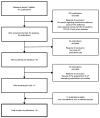Forecasting and Surveillance of COVID-19 Spread Using Google Trends: Literature Review
- PMID: 36231693
- PMCID: PMC9566212
- DOI: 10.3390/ijerph191912394
Forecasting and Surveillance of COVID-19 Spread Using Google Trends: Literature Review
Abstract
The probability of future Coronavirus Disease (COVID)-19 waves remains high, thus COVID-19 surveillance and forecasting remains important. Online search engines harvest vast amounts of data from the general population in real time and make these data publicly accessible via such tools as Google Trends (GT). Therefore, the aim of this study was to review the literature about possible use of GT for COVID-19 surveillance and prediction of its outbreaks. We collected and reviewed articles about the possible use of GT for COVID-19 surveillance published in the first 2 years of the pandemic. We resulted in 54 publications that were used in this review. The majority of the studies (83.3%) included in this review showed positive results of the possible use of GT for forecasting COVID-19 outbreaks. Most of the studies were performed in English-speaking countries (61.1%). The most frequently used keyword was "coronavirus" (53.7%), followed by "COVID-19" (31.5%) and "COVID" (20.4%). Many authors have made analyses in multiple countries (46.3%) and obtained the same results for the majority of them, thus showing the robustness of the chosen methods. Various methods including long short-term memory (3.7%), random forest regression (3.7%), Adaboost algorithm (1.9%), autoregressive integrated moving average, neural network autoregression (1.9%), and vector error correction modeling (1.9%) were used for the analysis. It was seen that most of the publications with positive results (72.2%) were using data from the first wave of the COVID-19 pandemic. Later, the search volumes reduced even though the incidence peaked. In most countries, the use of GT data showed to be beneficial for forecasting and surveillance of COVID-19 spread.
Keywords: COVID-19; Google Trends; forecasting; surveillance.
Conflict of interest statement
The authors declare no conflict of interest.
Figures
References
-
- WHO Coronavirus. [(accessed on 6 July 2021)]. Available online: https://www.who.int/health-topics/coronavirus#tab=tab_1.
-
- Tang D., Tou J., Wang J., Chen Q., Wang W., Huang J., Zhao H., Wei J., Xu Z., Zhao D., et al. Prevention and Control Strategies for Emergency, Limited-Term, and Elective Operations in Pediatric Surgery during the Epidemic Period of COVID-19. World J. Pediatr. Surg. 2020;3:e000122. doi: 10.1136/wjps-2020-000122. - DOI - PMC - PubMed
Publication types
MeSH terms
LinkOut - more resources
Full Text Sources
Medical
Miscellaneous


